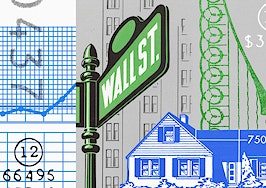This report is available exclusively to subscribers of Inman Intel, a data and research arm of Inman offering deep insights and market intelligence on the business of residential real estate and proptech. Subscribe today.
During the red-hot era of ultra-low mortgage rates, the real estate market saw homes fly off the shelves.
It may be a while before those shelves are fully restocked.
In March of 2019, there were 1.4 million homes for sale in the U.S. Three years later, the nation’s home inventory had been slashed in half to less than 727,000.
Along the way, economists and other real estate experts predicted that the market would slow eventually, leading to a replenishment of inventory and a market more balanced between buyers and sellers.
While that process began last year — culminating in 18 percent year-over-year inventory gains as recently as this February — the ongoing recovery stalled hard this spring, according to an Intel review of Zillow listings and pending-sales records.

Chart by Daniel Houston
By the end of May, inventory levels were roughly back to where they were at the same time last year — which is to say, near all-time lows.
The lack of new listings coming onto the market is not only preventing the housing market from rebalancing in favor of buyers. It’s also suppressing transactions across the board, Compass CEO Robert Reffkin said last week in an interview with Bloomberg Markets.
“There’s just not enough inventory,” Reffkin said. “And that’s because 30 percent of homeowners are locked into mortgage rates of 3 percent or below, and 70 percent of homeowners are locked into mortgage rates of 4 percent or below.”
In normal times, a short-term decline in inventory can be a sign of a healthy spring market, with more activity and heightened demand. But at this unique moment, some of the factors contributing to the inventory stall may prove tougher to correct, and even continue to suppress transaction levels, the Intel review suggests.
Buyers are dropping out — just not as fast as sellers
When mortgage rates raced upward from late 2021 to late 2022, it had a predictable effect on buyer demand: There was suddenly a lot less appetite to buy pricy houses.
Prices had been shooting up over the previous period. But for much of that time, mortgage rates were still in decline. This meant buyers who financed their home purchases found their mortgage payments to be affordable.
Then, over the span of less than a year, mortgage rates doubled as the Federal Reserve took steps to slow home-price growth, alongside other consumer inflation categories.
Buyers, predictably, were out.
But according to data reviewed by Intel, sellers hung on for longer during the early phase of the housing downturn. This appears to be one of the main drivers of the brief inventory recovery in 2022, as seen in the chart below.

Chart by Daniel Houston
The left part of the chart won’t surprise any real estate professionals who lived through the early stage of the pandemic housing boom. By late 2020, a decent-sized wave of new listings — represented by the white line above — was reaching the market. These new listings were just outnumbered by the sheer amount of interest from buyers. And over time, it greatly depleted the number of homes available to buyers at any given time.
Only in 2022 did this dynamic begin to reverse. Finally, sales were dropping off faster than new listings. This may not have been a good development for brokerages and other real estate businesses that depend on transactions. But it allowed many markets across the U.S. to make progress toward a more balanced state between buyers and sellers.
But in the very right-most part of the chart above, it’s clear that new listings remain in a depressed state, even as buyers have begun to dip their toes back in the water. The result of this shift? Those gains in inventory have since ground to a near-halt. And home prices even stopped falling nationwide.
Other factors may be contributing to the lack of new listings hitting the market.
“There will be a time when a flood of inventory comes back to the market,” Reffkin said. “I believe that will be when mortgage rates are closer to 5 [or] 5.5 percent, because if you have a 4 percent mortgage, you don’t want to roll that into 7 [percent] — but you’ll roll it into 5 [percent].”
In other words, Reffkin said, many homeowners treat their low mortgage rates as “a financial asset,” making them reluctant to list.
New normal, or seasonal blip?
Since the beginning of the pandemic housing boom, the idea of a “slow” winter season has at times seemed almost quaint, an anachronism of a time gone by.
This was especially true in the fast-paced winters of late 2020 and late 2021.
Sure, listings and home transactions slowed each of those years following the end of the summer rush. But competition for those listings remained unseasonably high, with more than half of the homes in the U.S. selling in fewer than two weeks even during the winter months. Just a few years earlier, homes took longer than a month to sell around that time of year.
This competition helped ensure that from 2020 to early 2022, home inventory wasn’t able to make the sustained gains that it typically does during the down months of the year.

Chart by Daniel Houston
Note the nearly complete lack of a spike in the length of time homes were spending on the market from 2020 to mid-2022. One way to interpret this: This most recent fall and winter marked the first semi-normal seasonal slowdown since the beginning of the pandemic. Just as importantly, it was followed by a semi-normal spring speedup in the time homes spent on the market.
It remains to be seen whether the slowdown in inventory gains since the start of 2023 will continue. But if it turns out to be merely seasonal, then the market rebalancing — and the associated inventory recovery — may well resume in the late summer and fall.
Buyer’s market in the distance
As Intel examined in a previous piece, Austin was one of the biggest boomtowns of the pandemic — and has since become one of the biggest busts in the ensuing home-price correction.
To put it mildly, Austin’s journey through the pandemic looks like that of few other places in the country. And part of that is reflected in its current status as by far the nation’s most extreme buyer’s market among the nation’s 100 largest metro areas, an Intel analysis found.
Typically, if a metro area has enough homes on the market at any given time that it would take at least six months to sell them all — also referred to as having at least six months of inventory — it’s thought to be a buyer’s market.
And Austin was alone among the largest U.S. metros in having more than eight months of inventory at the end of May.

Chart by Daniel Houston
Zillow’s records show the U.S. housing market as a whole was sitting on about three months of inventory at the end of May. This means most places are still a seller’s market — meaning, traditionally, that they have less than four months of inventory.
As highlighted in the chart above, one of the tightest markets remaining is in Washington, D.C., where there was less than two months of inventory at the end of last month. Seattle found itself in a similarly strong seller’s market.
Only eight of the 50 largest U.S. home markets were considered in a balanced or buyer-friendly range.
See the full list in the table below.













